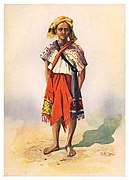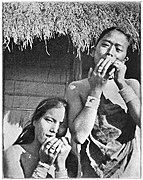Boro culture
| Part of a series on the |
| Culture of Assam |
|---|
 |
This article may need to be rewritten to comply with Bharatpedia's quality standards. (November 2018) |
Boro culture is the culture of the Boro people in Assam. For long, Boros have been farmers living in an Agrarian society[4] with a strong tradition of fishery, poultry, piggery, with rice and jute cultivation, and betel nut plantation. They make their own clothing from scratch, such as traditional attires. In recent decades, Boros are influenced by recent social reforms under Boro Brahma Dharma and the spread of Christianity.
Religion[edit]
Boros follow Bathouism, Boro Brahma Dharma and Shaivism. Some Boros practice Christianity, predominantly Baptists.[citation needed]
Music and dance[edit]
Bagurumba[edit]
The Boros traditionally dance the Bagurumba. This dance is accompanied by the Bagurumba song.
Moreover, there are about 15/18 kinds of Kherai Dance like Ranachandi, Gorai Dabrainai, Dao Thwi Lwngnai, Khwijema hannai, Mwsaglangnai.
Musical instruments[edit]
Among the many different musical instruments, the Boros use: Kham, Siphung, Serja, Jotha, Jabsring, Khawang, Bingi, Rege.
Siphung : This is a long bamboo flute having only five holes rather than six as the north Indian Bansuri would have and is also much longer than it, producing a much lower tone.
Serja : This is a violin-like instrument. It has a round body and the scroll is bent forward.
Khawang : It is a block of bamboo split into two halves for clapping.
Kham : It is a long drum made of wood and skin of goat.[5]
Cuisine[edit]
Food[edit]
Rice is the main staple food[6] but is eaten with non-vegetarian dishes like fish or pork.
Traditional dishes[edit]
Oma Bedor: Most Boro people like Oma (Pork) bedor (meat). Boros prepare pork meat with different flavors and style. It could be fried, roasted, and stewed. The first type is pan fried. The second flavor is made by roasting (or smoking) the meat in the sun for several days. The third one called "oma khaji" is cooked by mixing blood and meat, - it tastes very rich in fat.
Ondla: Ondla is a gravy made from rice powder and slices of bamboo shoots cooked lightly with oil and spices. Chicken or pork can be added to ondla.
Narzi: A bitter gravy that is made from dried jute leaves. Pork or fresh water fish can be cooked together to generate distinct taste. Narzi gravy tastes like Japanese sea weed soup! Others like Dau Bedor, Jinai and Samo are also likely taken by Boros.[5]
Alcoholic beverage[edit]
Jou Gishi: Rice beer is produced by the Boros from different kinds of rice varieties using traditionally created starter cakes called angkur.[7] The angkur contains a traditional recipe of herbs (dhapat tita, dhan, senikuthi, agara)[8] that provide Jou gishi with its distinctive flavour, colour, and ethno-medicinal properties and the consumption of Jou gishi is sometimes ritualistic on the occasions of festivals, marriages and communal gatherings.[9]
Festivals[edit]
Bwisagu[edit]
Bwisagu is the most cherished springtime festival celebrated by the Boro people at the advent of the new year. Famous for its myriad colours and merriment, it is celebrated during mid April.
The other festivals celebrated by the people are Hapsa Hatarnai, Wngkham Gwrlwi Janai, Domashi. Among all the Kherai festival includes singing, dancing and drumming celebrated with much rejoice.
Boro Attires[edit]
Aronai[edit]
Aronai is a small Scarf, used both by Men and Women.[10] Aronai is the sign of Boro tradition and is used to felicitate guests with honour, as a gift. In winter it is wrapped around the neck to warm up the body and generally used in the performance of Boro dance. In ancient period Boro warriors used Aronai as a belt in the battle field. At the time of the war, Boro women would weave Aronai within a single night and present it to the warriors as they set out for the battlefield.
Dokhona[edit]
Dokhona is the traditional dress of Boro women. In general the length of the Dokhona is 3 metres (m) and width is 1.5 metre (m), sometimes it depends upon the figure of the body. It is worn to cover the whole body from chest to legs by wrapping one round at a time over the waist. Varieties of Agor (design) and different types of colours are weaved for Dokhona. There are mainly two types of Dokhona- Plain Dokhona & Designed Dokhona. It can be divided into some sub types (according to design), it depends upon designers. They are -
Without design (Matha Dokhona or bidon)[edit]
- Plain (only line without design)
- Design with plain border line (pari lanai)
Designed (Agor gwnang)[edit]
- Whole body designed (mwdwm gongse agor)
- Designed in border only (jing jing aaolo agor lanai)
- Slightly designed in body as well as border (gejwraobw ese agor erdernai)
Matha Dokhona (bidon) is actually plain, without any Agor (design). Used to wear while worshipping of God. It is available with different colours but Matha Dokhona with yellow colour is used as a traditional bridal attire, which is known as Dokhona Thaosi (pure Dokhona). Along with Hinjao Gwdan (bride), Bwirathi (Women receptionist of bride and bridegroom in Boro marriages) wear Matha Dokhona. The favourite colours are generally Gwmw (Yellow), Gwthang (Green), and Bathogang (Colour of parrot's feathers). Nowadays Boro women wear different colours of blouse with Dokhona to cover her upper bosom.
Jwmgra[edit]
Boro women use Jwmgra (Scarf) to cover upper portion of the body (Length-around 2.5 metres, width-around 1 metre). They wear various colours of Jwmgra with varieties of Agor (design) to beautify themselves. The Hajw Agor (mountain design) is one of the most popular design among different designs.
Gamsha[edit]
The Gamsha is Boro male traditional attire.[11] Generally it is 2 metre (m) length & 1.2 metre (m) width. Boro men used to cover the portion from waist to knee by tying it in the waist. Gamsha can be different colours but Green with white (in border) is the most common colour in Boro Gamsha. Gamsha is compulsory to wear while worshipping the god and for Boro bridegroom.
Apart from the above mention attires, Boro women weave many types of traditional cloths such as Sima (like a bed cover), Wool (big wool scarf), Jwmgra gidwr (big scarf) and Phali (Handkerchief) etc.
Handmade designs of the Boros[edit]
Hundreds of Boro handmade designs are there, which always bloom on the Boro traditional attires. Most of the Boro weavers says that, the Hajw agor and Parwo megon is the most common and important design on Boro traditional attires. Among the popular handmade designs, the following are mostly used Agor (design) used by Boro women to decorate their attire[12][13] -
- Hajw Agor (design of hills)
- Bandhuram Agor (design first crafted by Bandhuram kachari)
- Phareo Megon (design like pigeon eye)
- Daorai Mwkhreb (winkle of peacock)
- Phul Mwbla (varieties of bloomed flowers)
- Dingkhia Mohor (design representing fern leaf)
- Bwigri Bibar (design representing the flowers of plum)
- Muphur Apha (design representing the footprint of bear)
- Agor Gidir (design like a diamond shape)
- Gorkha Gongbrwi Agor (design representing twill)
Tools[edit]
Khofri headgear to protect from sun and rain used by farmer.
Gallery[edit]
- Boro Phali with peacock and headgear motif.png
Boro Phali with peacock and headgear motif
Notes[edit]
- ↑ "639 Identifier Documentation: aho – ISO 639-3". SIL International (formerly known as the Summer Institute of Linguistics). SIL International. Retrieved 29 June 2019.
Ahom [aho]
- ↑ "Population by Religious Communities". Census India – 2001. Ministry of Home Affairs, Government of India. Retrieved 1 July 2019.
Census Data Finder/C Series/Population by Religious Communities
- ↑ "Population by religion community – 2011". Census of India, 2011. The Registrar General & Census Commissioner, India. Archived from the original on 25 August 2015.
- ↑ (Kachary 2017:251)Bodo farmer practices mainly wet cultivation methods using implements like wooden nangwl-jongal (plough) with the help of bullock and some times buffalo to plough the land. Again they also practice of ravi crops like jute, mustard seed, lentil, pulse, ashu paddy etc.
- ↑ 5.0 5.1 "HOME". udalguri.gov.in. Archived from the original on 10 April 2017. Retrieved 1 October 2017.
- ↑ Kachary 2017, p. 244.
- ↑ (Bhuyan & Baishya 2013:336)
- ↑ (Bhuyan & Baishya 2013:336)
- ↑ (Bhuyan & Baishya 2013:340)
- ↑ sachin (8 June 2015). "D'source Design Gallery on Motifs on Silks of Assam". D'Source. Retrieved 30 November 2020.
- ↑ (Kachary 2017:241)In case of male dress, it is carrier to trace the influence of the western dresses. Though the traditional gamsha is commonly used at home and at working time it is replaced by longpant and shirt commonly since long back while go out.
- ↑ Brahma 2016, pp. 53-54.
- ↑ Kachary 2017, pp. 76-80.
References[edit]
- Bhuyan, Biman; Baishya, Krishna (2013). "Ethno medicinal value of various plants used in the preparation of traditional rice beer by different tribes of Assam, India". Drug Invention Today. 5 (4): 335–341. doi:10.1016/j.dit.2013.09.002.
- Brahma, Banabina (2016). "Introduction of the Bodos". Incorporation of the eastern duars to the colonial rule the socio political and ethnic transformation of the bodos 1866-1993 (PhD). University of North Bengal. hdl:10603/195829.
- Kachary, Gwgwm Brahma (2017). Material culture of the bodos a descriptive analysis (PhD). Gauhati University. hdl:10603/220083.






